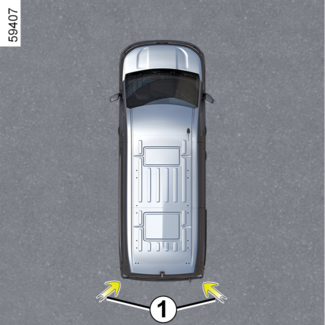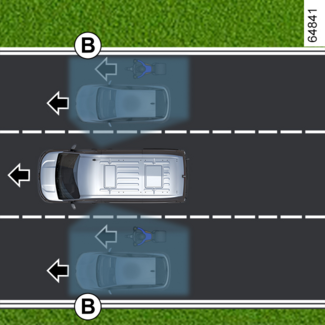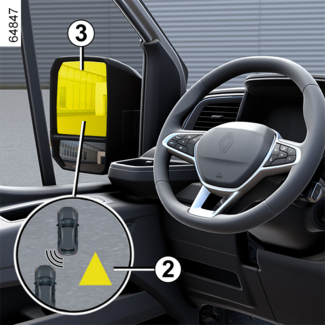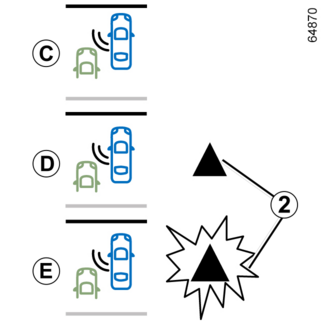Back to the list




Blind spot warning
Blind spot warning



Depending on the equipment, the vehicle may have one or both of the following functions:
Blind spot warning
Using information from both radars installed on each side of the rear bumper 1, the function warns the driver:
- when the vehicle speed is above approximately 9 mph (15 km/h);
- when a vehicle or cyclist is in zone A.
"Low-speed" blind spot warning
Using information from the radar installed on the driver's opposite side of the rear
bumper 1 or, depending on the equipment, from the two radars installed on each side, the function
warns the driver:
- when the vehicle speed is above less than 19 mph (30 km/h);
- when a vehicle or cyclist is in zone A and travelling at a lower speed than your vehicle, in the same direction;
or
- when a vehicle or cyclist is in zone B and travelling at a higher speed than your vehicle, in the same direction.
If the vehicle overtakes a vehicle or cyclist, the feature will only warn the driver
if the overtaken vehicle or cyclist is in the zone for long enough.
Tip
The function does not give a warning if vehicles or cyclists are not moving or, in
the case of the "low-speed" blind spot warning, if they are travelling at a speed
greater than approximately 12 mph (20 km/h).
Special feature
Ensure that the radar zone 1 is not obstructed (by stickers, mud, snow, etc.), impacted or modified (including
paintwork, etc.).
Operation
Warning light 2

Note: clean the door mirrors 3 regularly so that the warning lights 2 remain visible.
Warning light display 2

Display C
The function does not detect a vehicle or cyclist in zone A or B.
Display D
First warning: direction indicator not activated, indicator 2 indicates that a vehicle or cyclist is detected in zone A or B, on the same side of the vehicle as the indicator.
Display E
If the direction indicator is activated, warning light 2 flashes when the function detects a vehicle or cyclist in zone A or B.
If you deactivate the direction indicator, the function will return to the initial
warning (display D).
Note: the alert function is based on information from the radar. In certain situations
(traffic jams, etc.), it may alert any type of moving object that is in zone A or B.
Tip
If the vehicle is equipped only with the "low-speed" blind spot warning: warning light 2 is displayed only on the rear-view mirror on the side away from the driver (to signal
a vehicle or cyclist on that side).
Tip
If the vehicle is equipped with blind spot warning, warning light 2 is displayed on the right or left mirror depending on which side the vehicle or cyclist
is on.
Conditions for non-function
- The function is deactivated when reversing;
- the function is automatically deactivated and the message "Trailer: blind spot alert off" appears on the instrument panel if a towbar is electrically connected to the trailer hitch socket.
Temporarily not available
If a radar is obscured, the message "Side radars no visibility" appears on the instrument panel. Clean the area where the sensors are located. If
there is still a problem, contact an approved dealer.
For vehicles equipped with the "low-speed" blind spot warning, the  warning light also appears on the instrument panel, in the event that this function
is temporarily unavailable.
warning light also appears on the instrument panel, in the event that this function
is temporarily unavailable.
Operating faults
If the system detects a fault, the message "Check Side radars" appears on the instrument panel. Consult an approved dealer.
For vehicles equipped with the "low-speed" blind spot warning, the  warning light also appears on the instrument panel, if this function is not working
properly.
warning light also appears on the instrument panel, if this function is not working
properly.
WARNING
- The system’s detection range operates according to a standard lane width. If you are driving in wide traffic lanes, the system may not detect a cyclists in blind spot zones.
- In the event of very bad weather conditions (heavy rain, snow, etc.), the system may be temporarily disrupted. Remain aware of driving conditions.
Risk of accidents.
Warning
WARNING
This function is an additional driving aid. This function is not under any circumstances
intended to replace the due care and attention of the driver, who should at all times
be in control of the vehicle.
The driver should always adapt their speed to the traffic conditions, regardless of
the system indications. The system should under no circumstances be taken to be an
obstacle detector or an anti-collision system.
This function does not take the place of the driver.
System servicing/repairs
- In the event of an impact, radar alignment may be changed and its operation may consequently be affected. Consult your approved dealer.
- Any work in the area where the radar is located (repairs, replacements, etc.) must be carried out by a qualified professional.
Only an authorised dealer is qualified to service the system.
System disturbance
Some conditions can disturb or damage the operation of the system, such as:
- complex surroundings (metal bridges, tunnels, roads with barriers at the edge, etc.) ;
- poor weather conditions (snow, hail, black ice, etc.).
In these conditions, the system may not react or warn the driver inadvertently.
Limitation of the system operation
- The radar area should be kept clean and free of any modifications in order to ensure the proper operation of the system.
- Small objects moving close to the vehicle (pedestrians, etc.) may not be recognised by the system.
- The function warns you late when two other vehicles are approaching from the rear, side by side in the adjacent lanes (driving on a 3-lane road) and at a much higher speed than your vehicle.
- The vehicle is travelling on a winding road.
If the system behaves abnormally contact an authorised dealer.